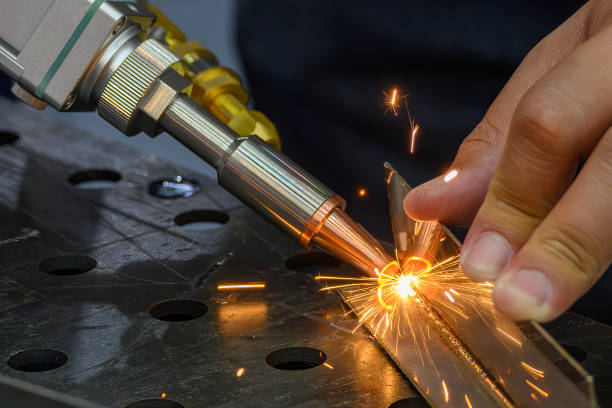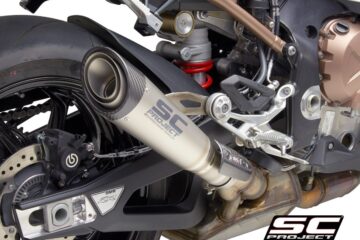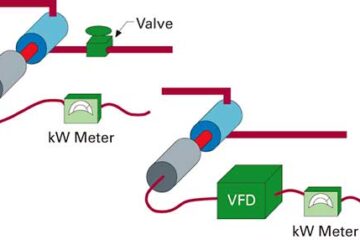Generally, the strength, precision, and overall quality of your welds depend on the technique you choose. If you’re in the metalwork industry, then you must have heard a thing or two about heard laser and TIG welding. Laser welding is favored for its speed and high-tech precision, and at the same time, TIG welding shines in tasks that demand accuracy and durability. But when it comes to pure strength, which one truly holds up better under pressure? In this article, we’ll explore the ins and outs of laser vs TIG welding. Keep reading to determine if laser welding is as strong as TIG welding.
What Is Laser Welding?
welder hands using portable handheld laser welding machine with sparks
Laser welding is a high-precision method of joining metals using a laser beam. This welding method works by focusing a concentrated beam of light on the workpiece. This intense light energy melts the metal in the desired area,. This allows for a clean and accurate weld. Further, laser welding stands out because it delivers deep penetration and narrow heat-affected zones. As a result, it is ideal for delicate or high-strength materials. This technique is widely used in industries where precision remains critical, such as aerospace and automotive.
Features of Laser Welding
Laser welding stands out for several features that make it unique:
- Laser Beam Precision: Laser welding employs highly concentrated beam of light that melts the metal surfaces at the exact point of the weld. The beam’s precision allows for highly controlled welding, especially useful in delicate or small-scale projects.
- High Energy Density: Laser welding delivers a high energy density at the welding point, enabling it to produce deeper, narrower welds. This is especially important for projects that require thin materials.
- Minimal Heat Distortion: Unlike traditional welding methods, laser welding focuses heat in a minimal area. This reduces the risk of warping or distorting the materials, which is critical for working with heat-sensitive materials.
- Automation-Friendly: Laser welding systems can easily integrate with automated manufacturing setups. The precision of the laser makes it ideal for robotic arms or CNC machines, streamlining production in various industries.
- Versatility: Laser welding can be used on various materials, including steel, aluminum, and even hard-to-weld metals like titanium and nickel alloys. This flexibility makes it suitable for many industries.
Pros of Laser Welding
Laser welding offers several distinct advantages that set it apart. Check them below:
- High Precision and Control : Laser welding gives you control over the weld. Because the laser beam can be finely focused, you can achieve precise welds on small, complex parts. It’s also great for creating neat seams and smooth finishes, minimizing the need for post-weld cleaning or polishing.
- Faster Processing Time: Laser welding works quickly, especially when dealing with thin materials. You can weld at high speeds with minimal setup time. This helps reduce project costs and turnaround times. Faster production makes it an attractive option for large-scale manufacturing.
- Minimal Heat Affected Zone: The laser’s narrow beam means only a small part of the material heats up during the process. This localized heat reduces the chance of warping or distortion in the surrounding areas. This is particularly beneficial when working with heat-sensitive materials or when maintaining the integrity of the base material is crucial.
- Non-Contact Process: Since there’s no need for direct contact between the tool and the metal, there’s less wear and tear on the equipment. This non-contact approach reduces the frequent need for maintenance and increases the lifespan of the machinery involved, saving money in the long run.
Cons of Laser Welding
Here are the downsides of laser welding:
- Higher Initial Costs: The main downside to laser welding is the cost. The machines are more expensive upfront than those used for other welding methods like TIG or MIG. This can make it difficult for smaller operations to justify the investment, though the long-term benefits may outweigh these initial costs.
- Requires Skilled Operators: Operating laser welding machines is not that straightforward. The technology requires a skilled operator who can control the beam’s intensity, speed, and focus for different materials. Quality training and experience are necessary to get the best results, which could add to labor costs.
- Limited Thickness of Materials: While laser welding is excellent for thin materials, it’s not always the best choice for thicker metals. The laser’s penetration depth is usually limited compared to methods like stick welding, making it less ideal for heavy-duty welding tasks.
What Is TIG Welding?
electrical arc coming off metal as a tig welder works in a shop
TIG (Tungsten Inert Gas) welding, also known as Gas Tungsten Arc Welding (GTAW), is a precise welding method that uses a tungsten electrode to produce the weld. It’s known for creating clean, quality welds, especially in delicate or thin materials. Unlike other types of welding, TIG requires more skill and control, as the welder manually feeds filler metal into the weld area while controlling the heat with a foot pedal or hand control.
Features of TIG Welding
Here’s what makes TIG welding stand out:
- Non-Consumable Tungsten Electrode: The tungsten electrode is the major component of TIG welding. It doesn’t melt like in stick welding; instead, it creates a stable arc that enables precise control over the weld. This gives TIG welding its reputation for producing high-quality, clean welds.
- Inert Gas Shielding: TIG welding uses an inert gas, usually argon, to protect the weld from contaminants in the air. This shielding gas flows continuously over the weld area, preventing oxidation and other impurities from affecting the weld quality.
- Filler Material Control: Unlike other welding methods where the filler material is fed automatically, TIG welding lets you manually add the filler rod to the weld pool. This gives you control over how much filler you use, which is crucial for creating smooth, consistent welds.
- No Spatter: TIG welding produces little to no spatter. This means less cleanup and a more aesthetically pleasing finish on your welds, which is crucial for visible or decorative projects.
- Dual-Hand Operation: TIG welding requires the use of both hands — one to hold the torch and the other to add filler material. This gives the welder more control but also requires a higher level of skill compared to methods like MIG welding.
Pros of TIG Welding
TIG welding is favored for high-quality, precision work. Check the benefits of this method below:
- High-Quality Welds: One of the most significant advantages of TIG welding is the quality of its welds. The method results in clean, strong welds that require little to no finishing, making it ideal for high-precision jobs.
- Great for Thin Materials: TIG welding excels when working with thin metals. The welder has precise control over the heat, reducing the risk of warping or burning through the material.
- No Need for Filler: In some cases, TIG welding can be done without using filler material. This is useful when welding thin sections or in situations where a clean, smooth appearance is crucial.
- Wide Range of Applications: TIG welding can be used on a wide variety of metals, including stainless steel, aluminum, copper, and exotic alloys like magnesium or titanium. This versatility makes it a go-to method for industries that need strong, precise welds.
Cons of TIG Welding
TIG welding also comes with its own set of challenges. Take a look at them below:
- Slower Process: TIG welding is much slower compared to other welding methods like MIG or stick welding. This can be a disadvantage when working on larger projects or when time is a factor.
- Requires High Skill Level: TIG welding is not a beginner-friendly process. It requires a steady hand and a lot of practice to master. The dual-hand operation and foot pedal control can be challenging for new welders.
- Expensive Equipment: While TIG welding produces high-quality welds, the equipment itself tends to be more expensive. This can be a barrier for small-scale operations or DIY enthusiasts.
- Not Ideal for Thick Materials: While TIG welding is excellent for thin metals, it’s not the best choice for thick materials. The process is slower and may not achieve the deep penetration required for heavy-duty welding.
Is Laser Welding as Strong As TIG?
Both laser welding and TIG welding are solid options when it comes to strength, but they excel in different kinds of jobs. Comparing the two, TIG welding tends to be stronger, especially when dealing with thicker materials or high-stress environments. TIG is the better option if you’re welding something that needs to take a lot of weight or pressure, like a car frame or a load-bearing part. It’s tough, reliable, and works well on various metals.
Laser welding, on the other hand, is better for more delicate, high-precision jobs. It’s faster and causes less distortion, which is great for fine details or smaller parts. However, its strength can be limited when dealing with thicker, heavy-duty materials. It’s not that laser welds are weak—they’re just not as deep or robust as TIG welds for bigger, tougher jobs.
Conclusion
In the end, laser welding and TIG welding have their strengths, but they’re suited for different needs. Laser welding excels when you need precision, speed, and minimal heat damage, especially with thin materials or detailed parts. However, if you’re dealing with thicker metals or need a weld that can withstand stress and pressure, TIG welding is the better choice. It offers more control, versatility, and overall strength for heavy-duty projects.
At Zintilon, we offer top-notch welding services that deliver quality results every time. Whether you need laser welder for delicate parts or more robust welding for heavy-duty materials, our expert team is ready to meet your needs. Get in touch with us today and experience reliable, quality manufacturing!



